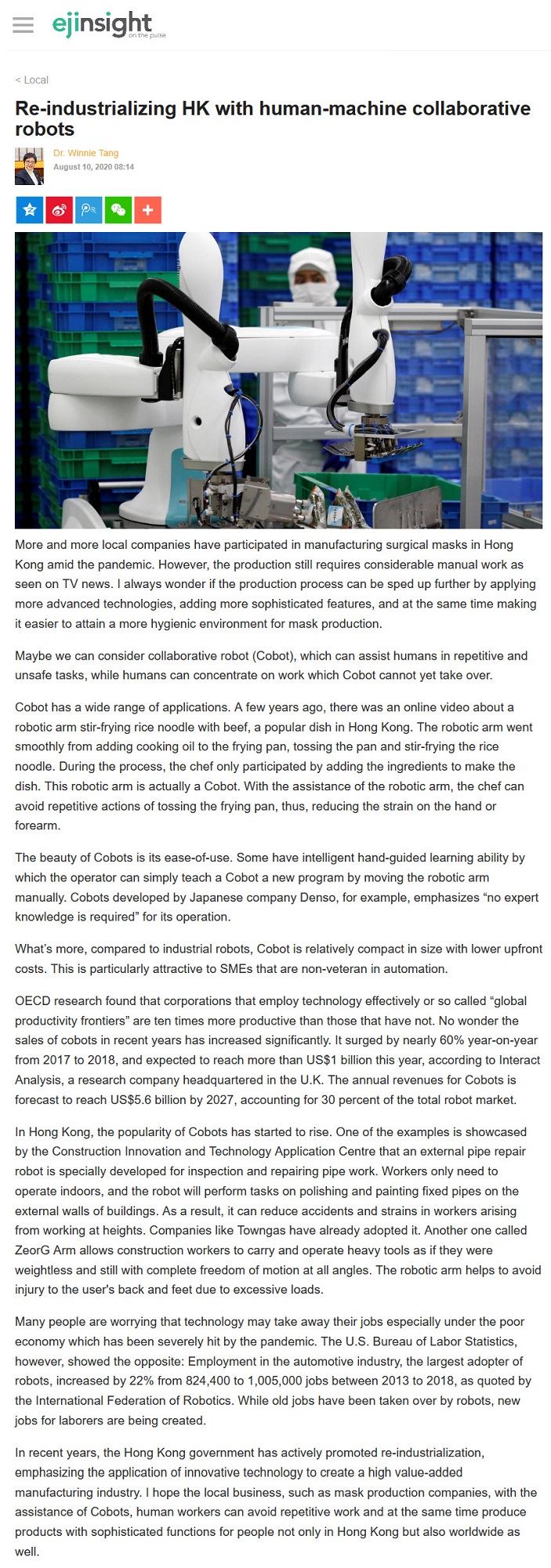網上版請按此

Re-industrializing HK with human-machine collaborative robots
More and more local companies have participated in manufacturing surgical masks in Hong Kong amid the pandemic. However, the production still requires considerable manual work as seen on TV news. I always wonder if the production process can be sped up further by applying more advanced technologies, adding more sophisticated features, and at the same time making it easier to attain a more hygienic environment for mask production.
Maybe we can consider collaborative robot (Cobot), which can assist humans in repetitive and unsafe tasks, while humans can concentrate on work which Cobot cannot yet take over.
Cobot has a wide range of applications. A few years ago, there was an online video about a robotic arm stir-frying rice noodle with beef, a popular dish in Hong Kong. The robotic arm went smoothly from adding cooking oil to the frying pan, tossing the pan and stir-frying the rice noodle. During the process, the chef only participated by adding the ingredients to make the dish. This robotic arm is actually a Cobot. With the assistance of the robotic arm, the chef can avoid repetitive actions of tossing the frying pan, thus, reducing the strain on the hand or forearm.
The beauty of Cobots is its ease-of-use. Some have intelligent hand-guided learning ability by which the operator can simply teach a Cobot a new program by moving the robotic arm manually. Cobots developed by Japanese company Denso, for example, emphasizes "no expert knowledge is required" for its operation.
What's more, compared to industrial robots, Cobot is relatively compact in size with lower upfront costs. This is particularly attractive to SMEs that are non-veteran in automation.
OECD research found that corporations that employ technology effectively or so called "global productivity frontiers" are ten times more productive than those that have not. No wonder the sales of cobots in recent years has increased significantly. It surged by nearly 60% year-on-year from 2017 to 2018, and expected to reach more than US$1 billion this year, according to Interact Analysis, a research company headquartered in the U.K. The annual revenues for Cobots is forecast to reach US$5.6 billion by 2027, accounting for 30 percent of the total robot market.
In Hong Kong, the popularity of Cobots has started to rise. One of the examples is showcased by the Construction Innovation and Technology Application Centre that an external pipe repair robot is specially developed for inspection and repairing pipe work. Workers only need to operate indoors, and the robot will perform tasks on polishing and painting fixed pipes on the external walls of buildings. As a result, it can reduce accidents and strains in workers arising from working at heights. Companies like Towngas have already adopted it. Another one called ZeorG Arm allows construction workers to carry and operate heavy tools as if they were weightless and still with complete freedom of motion at all angles. The robotic arm helps to avoid injury to the user's back and feet due to excessive loads.
Many people are worrying that technology may take away their jobs especially under the poor economy which has been severely hit by the pandemic. The U.S. Bureau of Labor Statistics, however, showed the opposite: Employment in the automotive industry, the largest adopter of robots, increased by 22% from 824,400 to 1,005,000 jobs between 2013 to 2018, as quoted by the International Federation of Robotics. While old jobs have been taken over by robots, new jobs for laborers are being created.
In recent years, the Hong Kong government has actively promoted re-industrialization, emphasizing the application of innovative technology to create a high value-added manufacturing industry. I hope the local business, such as mask production companies, with the assistance of Cobots, human workers can avoid repetitive work and at the same time produce products with sophisticated functions for people not only in Hong Kong but also worldwide as well.
Dr. Winnie Tang
Adjunct Professor, Department of Computer Science, Faculty of Engineering; Department of Geography, Faculty of Social Sciences and Faculty of Architecture, The University of Hong Kong